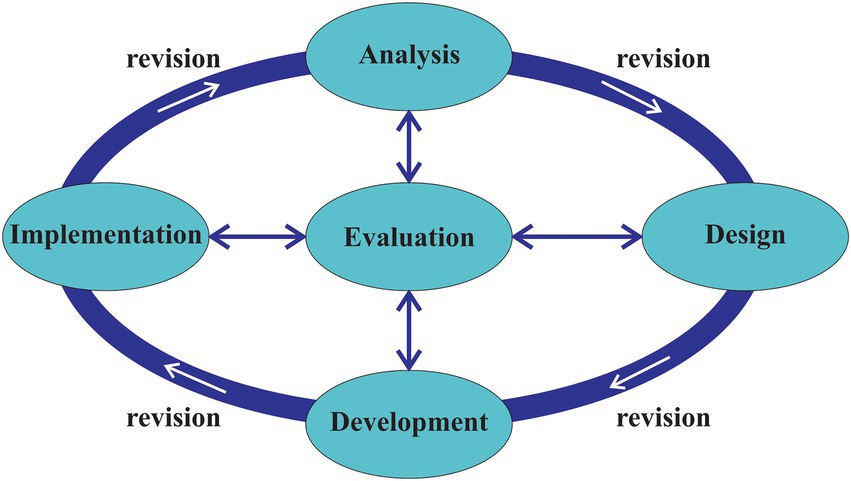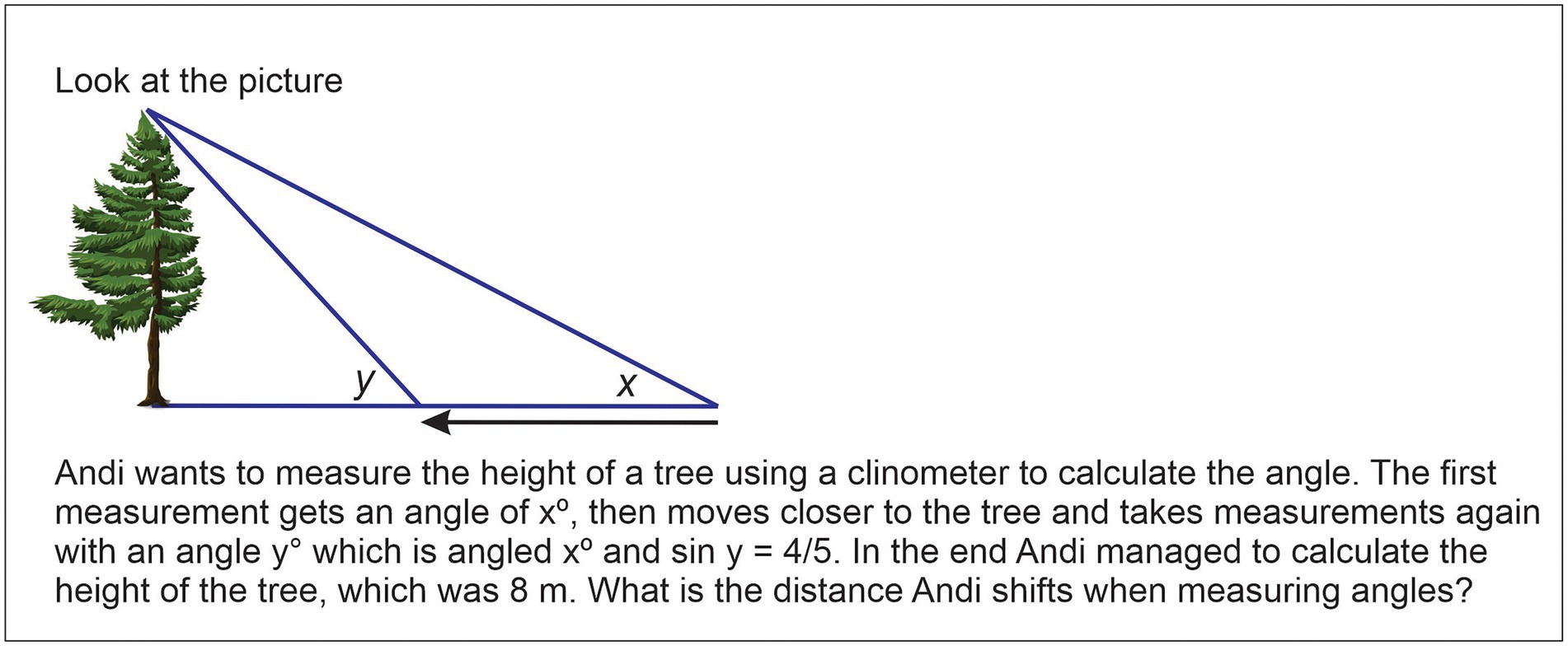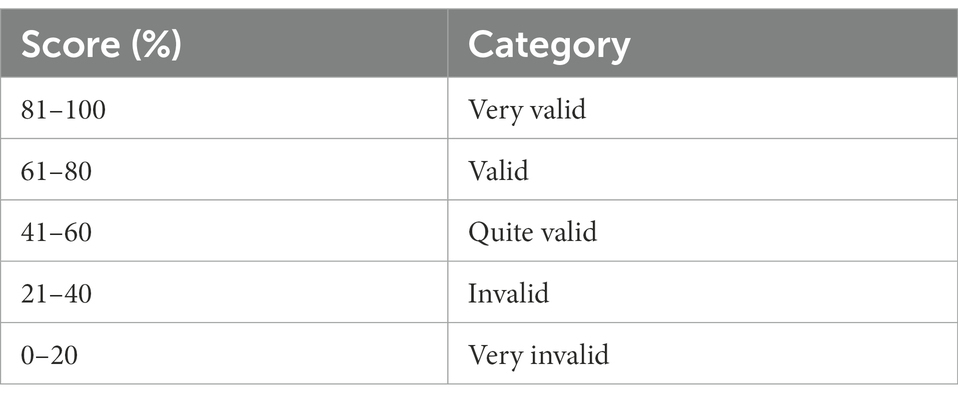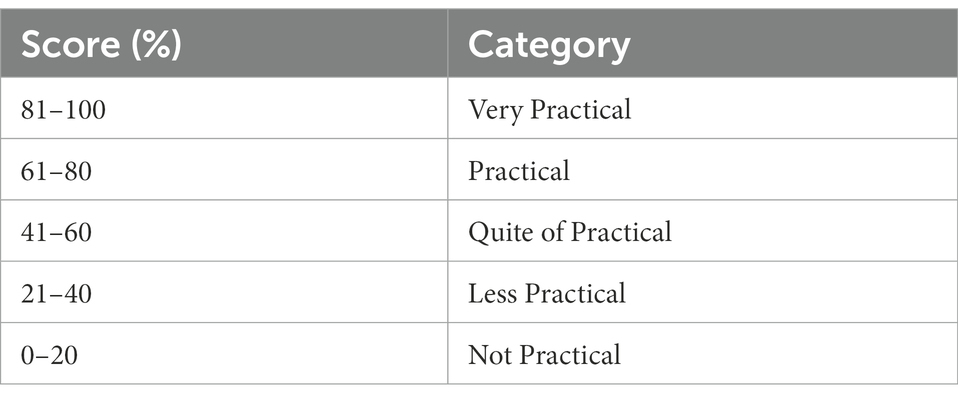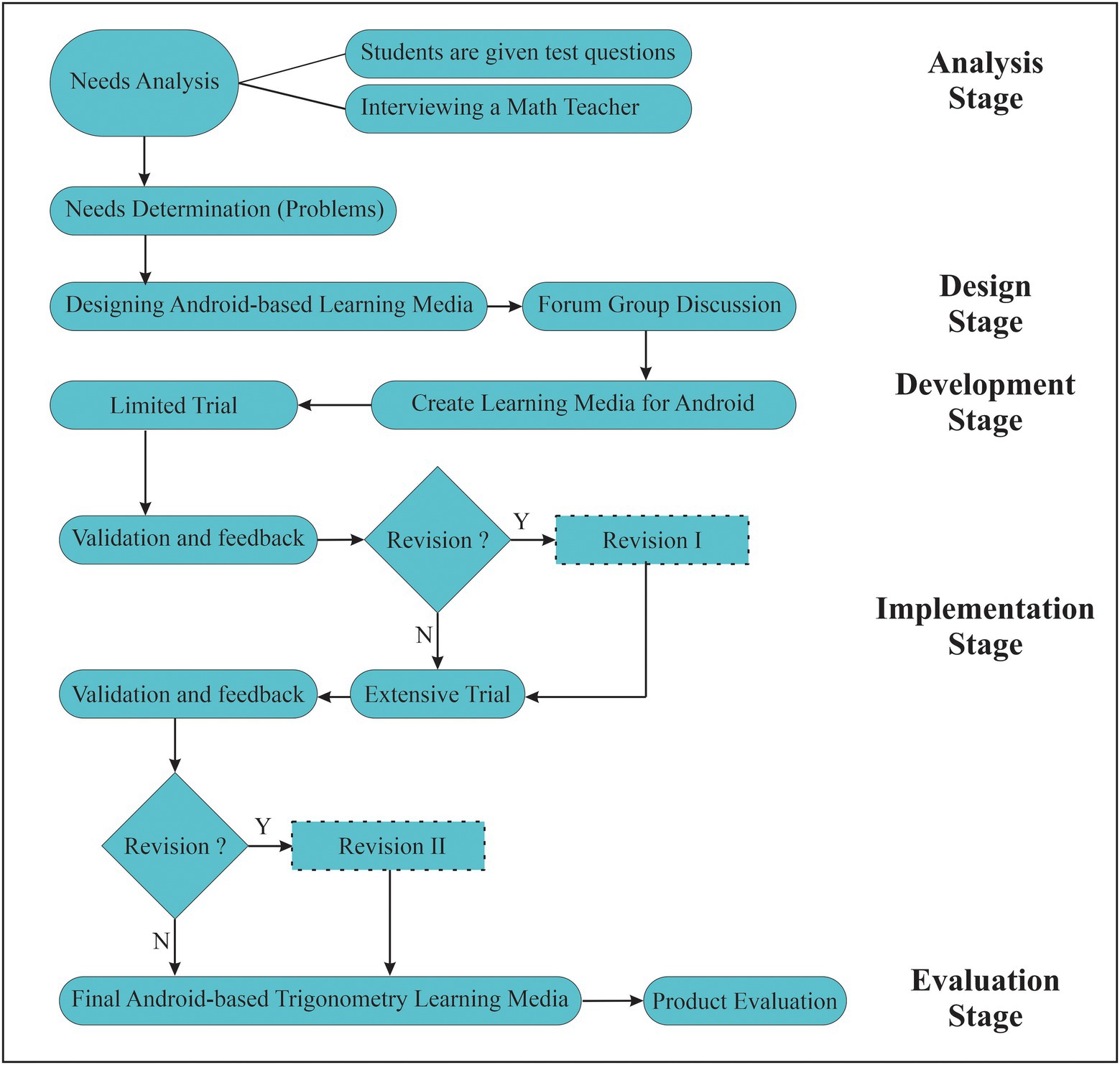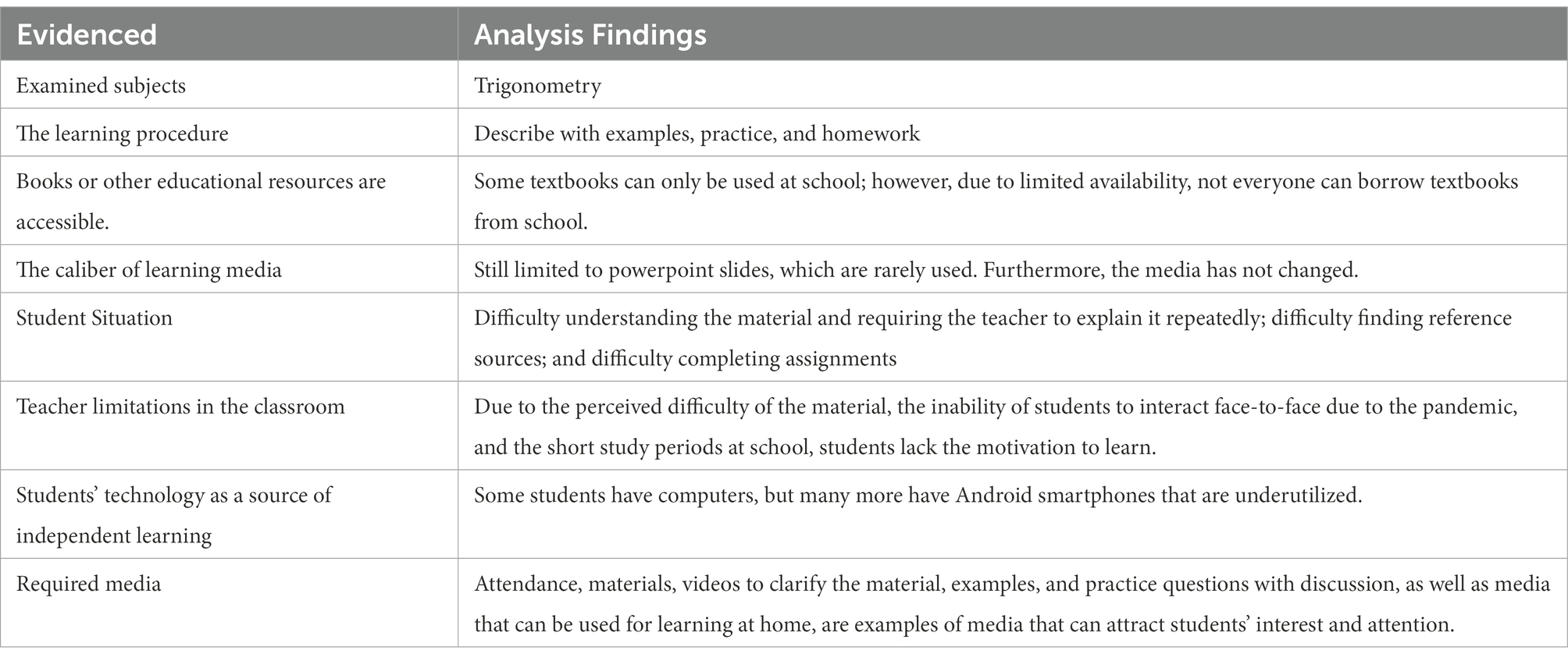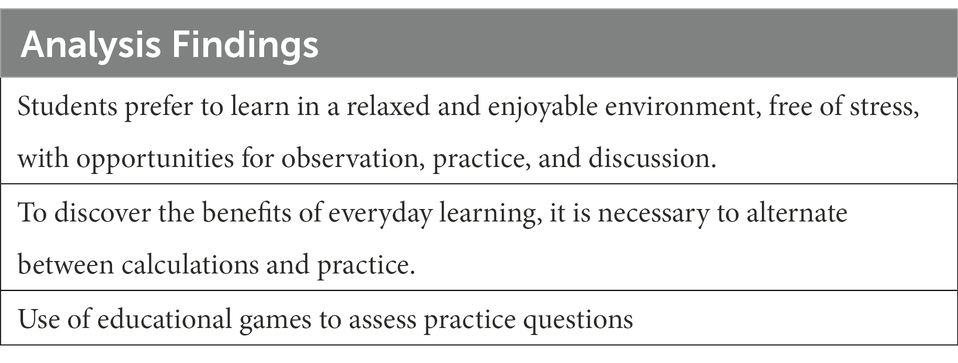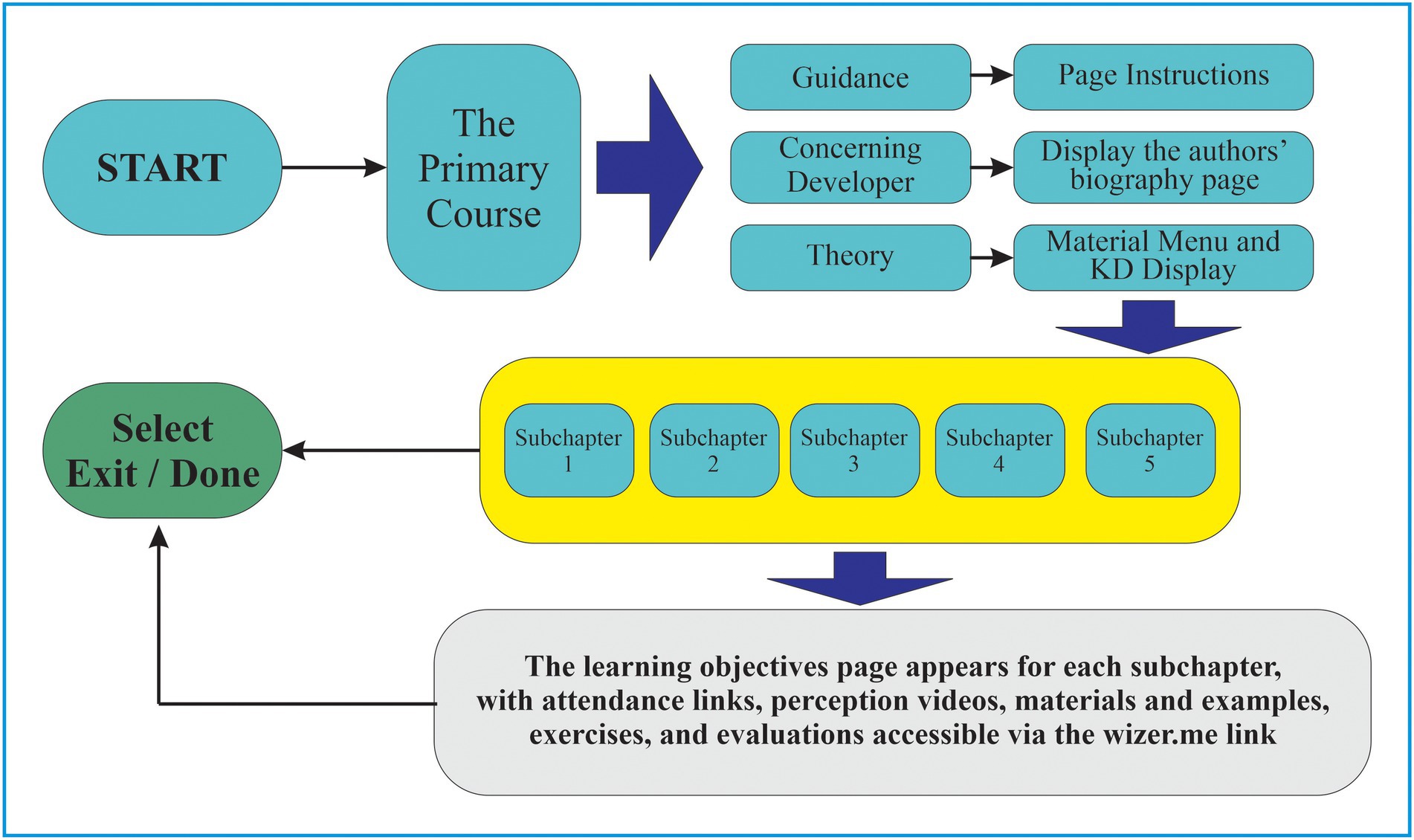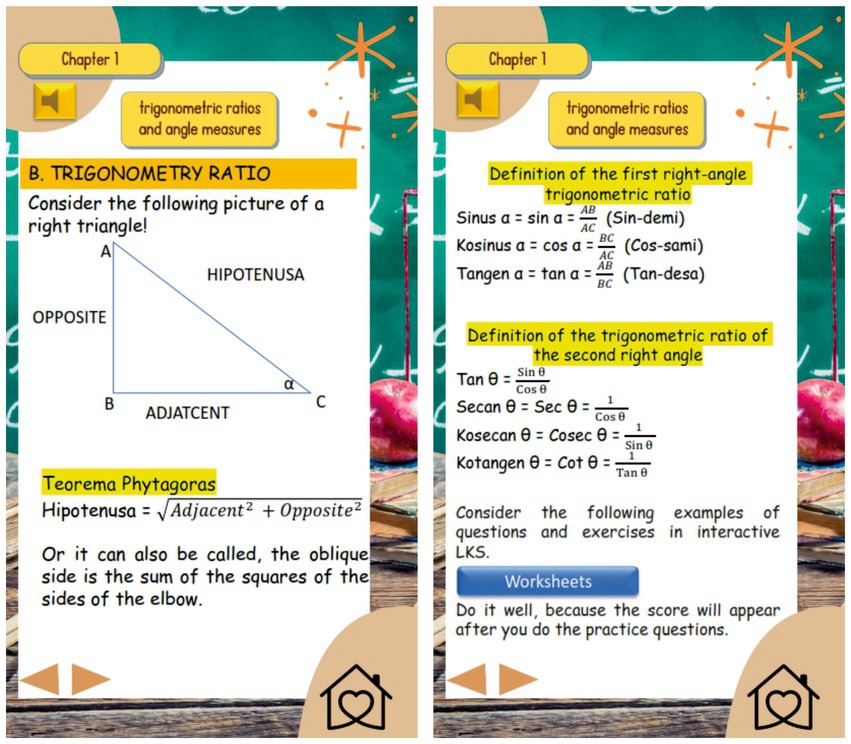- 1Department of Mathematics Education, IKIP Siliwangi, Cimahi, West Java, Indonesia
- 2Department of Tadris Mathematics, STAI Al-Bahjah, Cirebon, West Java, Indonesia
- 3Department of Mathematics Education, Universitas Sriwijaya, Palembang, South Sumatra, Indonesia
Using ICT-based interactive learning media is a learning method that strongly supports the teaching and learning process for students and teachers during the COVID-19 pandemic. This ICT-based learning media must be easily accessible to teachers and students, and one of the interactive media that is easily accessible is android-based learning media. This development research aims to design android-based learning media on valid trigonometric material and improve students’ mathematical critical thinking skills. This development research using the ADDIE model took 121 Ipeople consisting of expert validators, user (teacher), and students. The expert validators consisted of one mathematics education material expert and one ICT expert. Meanwhile, user represented by one mathematics teacher were involved in validating the use of the media design. In addition, there were participants from among students, which included 118 class X high school students throughout the Province of West Java, Indonesia, who took part in a limited trial phase of 20 people, an extensive trial of 50 people, and a product trial of 48 people. A sample of 118 students came from high school in the medium cluster. So, the reason for taking the sample represents the condition of students both on the island of Java and in Indonesia. The results showed that the developed android-based learning media was valid and could be used without revision with a combined percentage of 87.33%, with details of material experts at 84%, media experts at 92%, and validation by mathematics teachers at 86%. The results of the practicality test on students of 81% showed that the Android-based learning media design had a strong response, so the learning media made were very practical to use. The product test results show that the achievement of mathematical critical thinking skills of students who learn to use android-based learning media is better than those who learn not to use android-based learning media.
1. Introduction
The COVID-19 pandemic has forced the world of education to make maximum use of technology in the delayed learning process. Learning in mathematics that utilizes technological advances in the form of online learning can facilitate teachers and students simultaneously in delivering and obtaining subject matter (Chai et al., 2013; Bertram, 2020; Reddy et al., 2021; Mahmud et al., 2022; Su et al., 2022). One of the uses of online learning media that is currently in great demand by various groups is the use of Android on smartphones (mobile). The development of information technology has now been used in various schools to implement interactive learning media based on Android using a PC or smartphone.
The use of Android as a learning medium gets a positive response from various groups and also provides some convenience in the online learning process. Churiyah et al. (2020) recommend that there are several conveniences in android-based online learning, including for teachers that student learning outcomes can be known directly, learning activities are not limited to distance, time, and place, in the learning process, students can be accompanied by parents, students can access the network with the internet, students can take advantage of the media in their surrounding environment and have a lot of time with family. Irfan and Wulandari (2019) stated that on Android-based learning media, students can learn more easily without being limited by time and place, nor do they need to carry books. The development of learning media at this time has utilized multimedia elements that are packaged in the form of an Android application so that it can reduce student boredom in learning. However, the obstacles that often arise are not only from student factors but also from teachers and media or teaching materials that play an important role in the mastery of understanding students’ prerequisite materials (Rohaeti et al., 2019; Sulistyo and Kurniawan, 2020; Tran et al., 2020; Wijaya et al., 2020; Pertiwi et al., 2021; Hidayat et al., 2022).
In addition to the benefits that are a positive impact of using Android, there are also some negative impacts that arise, including that there are still many students who do not focus on learning because they are too busy with their cellphones used for social media and also playing games (Irfan and Wulandari, 2019). In addition, there are also some groups who still have difficulty getting internet access, and there are also families who do not have mobile devices. However, the positive impacts are far greater than the negative impacts. The government has also taken measures to minimize the negative impact by providing study quota assistance and creating study groups so that students who do not yet have devices can still study by joining with friends who have mobile devices.
Android-based learning media uses cellphones as a tool to facilitate effective and efficient learning so that students may learn (Martono and Nurhayati, 2014; Novaliendry et al., 2020). This is due to the Linux-based Android operating system for mobile devices, including smartphones and tablet computers, which Google and the Open Handset Alliance developed. Android is intended to be an operating system that offers developers an open-source platform to build applications (Hakky et al., 2018; Irfan and Wulandari, 2019; Sari and Wati, 2020). Since smartphones and tablets may be used as learning aids anytime, anywhere, and with a high level of practicality, attractiveness, efficacy, and efficiency, android-based learning media is a learning medium.
Irfan and Wulandari (2019) note that the eligibility criteria for android-based learning media are categorized into two aspects, namely content or material aspects and media aspects. Aspects of the material can be viewed in terms of suitability, quality of content and objectives, and instructional quality. The media aspect can be viewed in terms of ease of use and navigation, in terms of aesthetics or beauty, in terms of media integration, and in terms of technical quality. While the criteria for android learning media, according to Sari and Wati (2020), are carried out based on student questionnaires with several aspects as follows: (1) Practical aspects; (2) Aspects of visual appearance; (3) language aspect; and (4) Aspects of effects for learning strategies. Meanwhile, according to Hakky et al. (2018), the eligibility criteria for android-based learning media are divided into two, namely material assessment and media assessment. The assessment of a piece of content takes into some factors, including: (1) the relevance of the content; (2) the structure of the content; (3) the evaluation and practice questions; (4) the linguistic element; (5) the effects on learning techniques; and (6) the visual appeal. The media evaluation also takes into account: (1) language features; (2) effects on learning techniques; (3) factors of software engineering; and (4) aspects of aesthetic appeal. While evaluating student responses, considerations for both learning methodologies and visual appeal are taken into account.
The eligibility criteria for the Android-based learning media used are similar, then the researchers used three criteria: material criteria, media criteria, and student response questionnaires. The material assessment criteria are divided into several categories: (1) the material’s relevance; (2) its organization; (3) evaluation and practice questions; (4) the language aspect; (5) the effects on learning strategies; and (6) its visual appearance. Language aspects, effects for learning strategies, software engineering aspects, and visual appearance aspects are all included in media evaluation. The following topics are covered in student response questionnaires: (1) practical aspects, (2) visual appearance aspects, (3) language aspects, and (4) effects on learning strategies.
Trigonometry is one of the mathematical topics that can help you develop more mathematical skills (Basir and Maharanib, 2018; Wijaya et al., 2020). Furthermore, trigonometrical material is used in many other fields of science, such as architecture, navigation, engineering, studying the motion of celestial bodies such as the sun, moon, and stars and their calculations, and several other branches of physics (Purwanti, 2017; Basir and Maharanib, 2018). There are so many roles for this trigonometry material that it is critical that students understand it at the high school level and even higher, namely in college, where trigonometry material appears frequently and becomes one of the requirements for graduation.
Trigonometry’s importance is still not balanced with students’ mathematical critical thinking skills. Higher-order thinking skills in mathematics are expected to be important learning outcomes (Lewis and Smith, 1993; Kurniati et al., 2015; Abdullah et al., 2016; Zetriuslita and Ariawan, 2021; Hendriana et al., 2022). The ability to solve non-routine problems is defined as critical thinking (Mogari and Chirove, 2017; Kurniati and Asari, 2019; Sari and Hidayat, 2019). Thus, critical thinking skills can be defined as logical thinking that is reasoned and focused on solving mathematical problems (Lewis and Smith, 1993; Widyatiningtyas et al., 2015; Paul and Elder, 2019). Thus, mathematical critical thinking ability is a systematic ability that can be used to solve mathematical problems by combining prior knowledge with mathematical reasoning abilities.
However, in reality, mathematics learning activities in Indonesia have not fully trained students’ critical thinking skills. This can be proven from several times the results of the Trends in International Mathematics and Science Study (TIMSS) with high-level cognitive questions that measure critical thinking skills. In the 2015 TIMSS, Indonesia was ranked 46th out of 51 countries with a score of 397 (Safari, 2021). Then in the 2018 Program for International Student Assessment (PISA) results, it shows that Indonesia’s achievement in mathematics has a score of 379 which indicates a decrease of 7 points from that obtained in 2015 (Setiawan et al., 2021). This concludes that the improvement of students’ mathematical critical thinking skills still needs to be improved.
Student’s difficulties in learning trigonometry during the COVID-19 pandemic make it urgent to research teaching media development. In this case, the researcher studied the effect of android-based learning media on trigonometry material to improve students’ mathematical critical thinking skills. This research is expected to produce a valid product about android-based learning media in trigonometry material. In addition, the resulting product can also meet practical aspects so that it can be widely applied in learning.
Aside from the above study, the authors want to see how much Android-based trigonometry learning media is expected to improve students’ mathematical critical thinking skills during the COVID-19 pandemic. This study aims to analyze and investigate: (1) the process of developing android-based learning media on trigonometric material; and (2) the results of the application of android-based trigonometry learning in improving students’ mathematical critical thinking skills.
2. Research methods
The ADDIE (Analysis, Design, Development, Implementation, and Evaluation) model is used in this development research to create android-based learning media on trigonometry material to improve students’ mathematical critical thinking skills during the COVID-19 pandemic. Figure 1 depicts the stages of the ADDIE development model.
Participants involved in developing the implementation of this android-based learning media product amounted to 121 people, expert validators, the user (teacher), and students. The expert validators consisted of one material expert in the field of mathematics education (Dr. Sri Adi Widodo, M.Pd, lecturer at the Universitas Sarjanawiyata Tamansiswa, Yogyakarta, Indonesia) and one ICT expert (Dr. Surya Amami Pramuditya, M.Sc, Head of Media and Learning Device Development at the Universitas Swadaya Gunung Jati, Cirebon, Indonesia). Meanwhile, the user represented by one of the mathematics teachers (Agie Ginarnjar, S.Pd, Guru SMA Negeri 2 Padalarang, West Java, Indonesia) was involved in validating the use of media designs. In addition, there were participants from among students, which included 118 class X high school students throughout the Province of West Java, Indonesia, who took part in a limited trial phase of 20 people, an extensive trial of 50 people, and a product trial of 48 people. A sample of 118 students came from high school in the medium cluster. So, the reason for taking the sample represents the condition of students both on the island of Java and in Indonesia.
The subject matter of trigonometry that is used as the focus of this research is: (1) Trigonometric ratios and angle measures; (2) Special angle trigonometric ratio; (3) Graphs of trigonometric functions; and (4) The sine, cosine, and area rules of a triangle.
Students’ mathematical critical thinking ability is measured through a test with the characteristics of a good critical thinking ability test. The following is an example of a student’s mathematical critical thinking ability test (see Figure 2).
2.1. Analysis stage
The analysis is performed to determine the learning needs and competencies that students must master. Details of activities during the analysis stage, specifically:
a. A user needs analysis is a study that is conducted to determine what is required in the development of learning media. The information was gathered through interviews with the goal of eliciting information about problems encountered while learning trigonometry material.
b. Identification of needs (problems) seeks to discover the solutions that must be proposed in the design of android-based learning media in order for students to master the competencies required.
2.2. Design stage
This stage’s activities are divided into five steps, which are as follows:
a. Developing competencies, namely developing specific competencies that students must achieve in designing android-based learning media, so that students can be self-sufficient (mathematical critical thinking skills).
b. Determine the learning material, which is trigonometry in class X SMA. This material was chosen to keep the discussion from becoming too broad.
c. The researcher creates an android-based learning media strategy to aid the learning process and ensure that the predetermined competency goals are met. This product contains at least three media that are combined into one, namely a Google Form, a Wizer.me interactive worksheet, and an Apperception video.
d. Evaluation, specifically evaluating the equipment and conditions required by students in order to achieve the learning competencies that are expected.
e. Sources, specifically locating and determining learning resources that can aid in the creation of this android.
2.3. Development stage
The development stage consists of producing or creating specifications for android-based learning media that were determined during the design stage. The android-based learning media must then be validated before being used in the learning process once it has been completed in production. Activities carried out during the development stage include:
a. Creating learning media, specifically Android-based learning media Android-based learning media is created with the PowerPoint application, which is easily accessible on a laptop. Furthermore, it is converted into an application using APK Builder Pro 3.4, so that it becomes a product in.html and is ready to be explored into an application that is ready to be installed. Making android-based learning media that is scientifically tailored to the needs of students learning trigonometry material.
b. Validation of Learning Media, which includes expert, user, and audience validation in the form of a questionnaire the validation of learning media. This validation is intended to gather feedback for revising android-based learning media so that it can be said to be usable.
In this case, expert validation is performed by a single lecturer who is both a material expert and a media expert. Mathematics teachers perform user validation, and students are tested for audience validation. The validated criteria for assessment aspects include:
a. Material expert assessment: (1) aspects of material relevance; (2) aspects of material organization; (3) aspects of evaluation and practice questions; (4) language aspects; (5) effects of learning strategies; and (6) visual appearance.
b. Evaluation of media experts: (1) language aspects; (2) effects on learning strategies aspects; (3) software engineering aspects; and (4) visual appearance aspects.
c. User evaluation: (1) aspects of material relevance; (2) aspects of the material organization; (3) aspects of evaluation and practice questions; (4) language aspect; (5) effects for learning strategies; and (6) visual appearance.
d. A student response questionnaire with three sections: (1) language aspects, (2) effects for learning strategies, and (3) visual appearance aspects.
Rubric or product development validation criteria are presented in Table 1.
In addition to focusing on the design and manufacture of android-based learning media, at this development stage, simulations were also carried out to support the validation stage (especially the student response questionnaire). Simulations were carried out on class X SMA students in the form of a limited trial of 20 people, an extensive trial of 50 people (from two classes in two schools), and a product test of 48 people (from two classes in one school, each with 24 students). The lesson design in this study is in the form of distributing student response questionnaires that have been given simulations using android-based media that have been created. Rubric or product development practical criteria are presented in Table 2.
2.4. Implementation stage
The implementation stage is when the mathematics teacher delivers learning material in the classroom. Material is submitted using android-based learning media that has been validated by experts, as well as a control class that does not receive media as a benchmark for evaluating material for the experimental class. The number of samples at this implementation stage was 48 from two classes (24 people each).
Experimental and control class were determined randomly, and both classes had the same ability based on the average achievement of the previous material. Before the product test was carried out, the two classes had yet to experience learning using android-based media.
One of the objectives of this research is to improve students’ mathematical critical thinking skills using android-based learning media that has been developed. Therefore, a mathematical critical thinking ability test was conducted at the end of the lesson. The results were analyzed using a statistical test, the independent sample t-test, using JASP Statistics software.
2.5. Evaluation stage
The evaluation was carried out to determine the quality of the finished products, which were android-based learning media. This level of quality will be evident if android-based learning media can improve students’ mathematical critical thinking skills both before and after learning. In this step, the researcher classified the data to improve students’ mathematical critical thinking skills, which would be measured using test questions administered at the beginning and end of the lesson. If students’ mathematical critical thinking skills improve, learning with android-based learning media is considered successful; however, if there is no improvement or a decrease, the developed android-based learning media must be improved. Figure 3 depicts the entire flow of research and development activities.
3. Results
This development produced learning media in the form of Android applications based on Trigonometry material. The resulting application is a file with an.apk extension that is installed on an Android smartphone. PowerPoint is used as a medium for application development, which is then exported into an application using Website 2 APK Builder Pro 3.4. It also makes use of several supporting applications, such as g-form, interactive worksheets, and interactive videos, to create self-contained applications that teachers, students, and parents can easily control. The outcomes of the development stages used in the ADDIE development model (Analysis, Design, Development, Implementation, and Evaluation).
3.1. Analysis stage
The following steps are required to determine the initial needs for developing learning media: (1) User Needs Analysis, (2) Student Learning Style Analysis, and (3) Curriculum or Content Analysis. Before moving on to the user requirements analysis stage, the problem is identified and the required solution is determined. Based on observations of classroom learning, student interviews, discussions with mathematics teachers, and readings from various articles, problems were identified, including students’ basic mathematical abilities and lack of interest. This is caused by a number of things, including the lack of independent learning media, a lack of innovation and variety in the use of media, and a lack of use of Android devices as learning tools. Making learning media can be used to solve previous issues.
The need for the product is determined by analyzing user needs. Table 3 shows the data from observations and interviews used to determine needs.
The findings of the observations and interviews are then analyzed to determine user needs, which are supported by the specifications/features of learning media (see Table 4).
The analysis results related to the required features and content (see Table 2) must have the characteristics of learning media to produce a good display. This media development incorporates Alessi and Trollip’s (Alessi and Trollip, 2000) media characteristics, namely: (a) introduction to learning media; (b) student control; (c) consistency; and (d) presentation mode. The start page in the form of the media title and developer identity marks the beginning. A login button is presented so that users can proceed to the next page. Student control allows users to interact with learning media. Control is accomplished through the use of specific buttons, namely menu and navigation buttons. In learning media, menu buttons include buttons for various menu options. Navigation buttons are used to move to specific pages, such as (1) Home, which takes you to the main page of learning media, (2) Next, which takes you to the next page, and (3) Back, which takes you back to the previous page. The goal of consistency is to make learning media more convenient for users. The following components have consistency applied to them: (1) putting the home, next, and back buttons at the bottom; (2) using consistent keys for the same purpose; (3) using consistent paragraphs, font sizes, and font types in the text; and (4) using a consistent color for one-way sections. While the presentation mode depicts the presentation of content in accordance with the requirements of visual elements, namely: (1) readability of media text, where learning is developed using clear and easy-to-read text. The font used is Maiandra GD, which is a suitable size and easy to read. Furthermore, the text color is adjusted to match the background color so that the text is legible. (2) Graphic quality is used in a display that is arranged with artistic quality and attractiveness. A good color element is presented with a maximum of five color shades. (3) Video quality The video in this lesson is used to visualize the material through various examples from everyday life.
The next step is to analyze student learning styles after identifying user needs. This analysis is useful in determining what type of media will be created to suit students’ learning styles in order to improve students’ learning motivation. Table 5 shows the results of the analysis of student learning styles.
At the curriculum analysis or content stage, namely material relevant to the specified basic competencies. According to the syllabus, basic competencies and objectives/indicators are required for developing trigonometry learning media. Angle measures and trigonometric ratios, trigonometric ratios of special angles, graphs of trigonometric functions, rules of sin, cos, and area of triangles, and functions of trigonometric equations are all organized around these fundamental competencies. At this stage, the material compiled is guided by a variety of sources, including books, modules, and other supporting materials.
Other content that will be included in the learning media, such as videos, examples, and practice questions, must be determined in advance, in addition to the material. The videos created in this application are in the form of light videos at the beginning of learning that contains illustrations and examples of the application of trigonometry material to daily activities, and several videos are also given as examples of problem-solving. Practice questions are presented in wizer.me interactive worksheets to facilitate student work and teacher correction, and can be emailed to parents.
3.2. Design stage
The design phase produces a flowchart that describes the sequence and structure of learning media, a storyboard with a template design plan, and an interface design. The created flowchart is then used as a guide for designing storyboards, resulting in a planning design that is in accordance with the media structure (see Figure 4).
The storyboard is a rough outline of the display of the learning media that will be created, including the media’s content, layout, and the majority of the elements that will be included (Jones, 2008; Herbst et al., 2014; Webel and Conner, 2017). The story-board is then used as a guide in creating the interface design. The interface design creates a real storyboard representation by paying attention to the previously analyzed elements and characteristics of the learning media, such as balance, color, text, graphics, and others (see Figure 5A). The storyboard design is then translated into a real display or interface design to make it more appealing and user-friendly (see Figure 5B). Furthermore, each resource includes information on learning objectives and attendance links (see Figures 5C,D).
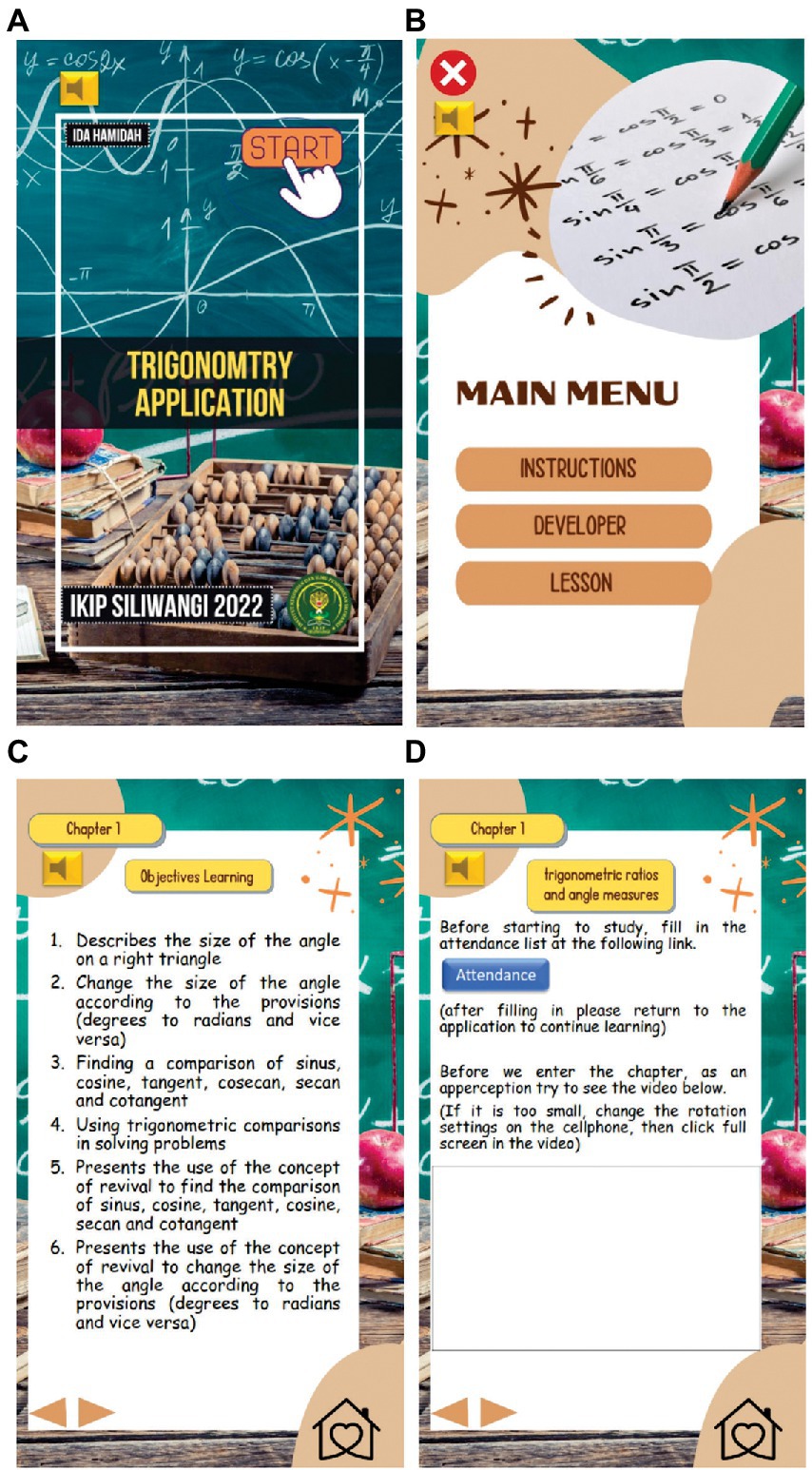
Figure 5. Interface design (A) homepage, (B) default menu page, (C) learning goals, and (D) attendance links.
Exercises are also presented as a worksheet on each material page (see Figure 6). It is intended to continue to hone students’ mathematical critical thinking abilities.
3.3. Development stage
Development is the stage of product development and testing in which the results of the analysis, and design are transformed into a complete finished product and validated by experts, specifically material and media experts. In addition to validation, the developer requests feedback and suggestions from expert validators in order to improve the developed media.
3.3.1. Making educational media
This android-based learning media is created in PowerPoint, which is then converted into an html file product by APK Builder Pro 3.4 and is ready to be explored into an application that is ready to be installed.
3.3.2. Learning media validation
Experts validate learning media (material experts, media experts, and users). Dr. Sri Adi Widodo, M.Pd. is the material’s validator (Lecturer of Mathematics Education, Universitas Sarjanawiyata Tamansiswa Yogyakarta, Indonesia). Users validate the development of learning media, in addition to material experts and media experts. Agie Ginanjar, S.Pd., is a mathematics teacher at SMA Negeri 2 Padalarang in West Bandung, Indonesia. Table 6 shows the results of material and user/teacher validation.
Dr. Surya Amami Pramuditya, M.Sc. is the media’s, validator the media. He is the Head of Media and Learning Device Development at Indonesia’s Gunung Jati Swadaya University. Table 7 summarizes the media expert validation results.
Based on the findings presented in Tables 6, 7, the overall product validation results summary is 87.33% (very valid), so the product design in the form of android-based learning media can be used without revision.
3.3.3. Simulation
The simulation was performed on class X high school students in the form of a limited trial of 20 people, an extensive trial of 50 people (from two classes in two schools), and a product test of 48 people (from two classes in one school, each with 24 students). The lesson design in this study takes the form of distributing student response questionnaires that have been given simulations using created android-based media. Table 8 summarizes the results of limited trials, extensive trials, and product trials.
With a response score of 81%, the analysis of student response results revealed a strong interpretation (see Table 8). This demonstrates that students feel helped in increasing mathematical critical thinking skills after receiving android-based learning media on trigonometry material. Furthermore, the developed product or media has been declared valid and can be used for learning (see Table 8).
3.4. Implementation stage
Experiments were conducted on students from two classes in one school, each with 24 students. The first class is known as the experimental class, and the second is the control class. The experimental class consists of students who learn using the developed Android application media, while the control class consists of students who learn without using the developed Android application media.
Based on the assumption test analysis using JASP Statistics software, it is found that the data is normally distributed and has a homogeneous variance. This is followed by a parametric test, namely the independent sample t-test (see Table 9).
The p-value from the independent sample t-test results (see Table 9) is 0.007. As a result, those who learn using the developed android application media have better mathematical critical thinking skills than those who do not learn using the developed android application media.
3.5. Evaluation stage
The ADDIE model’s final stage is evaluation. The researcher solicited responses from students who had studied with the developed Android application media during this stage of evaluation. Each action elicits a variety of reactions, both positive and negative. The most common positive response is that students’ learning processes are more flexible. Students can study wherever and whenever they want. Students can also study the material thoroughly and freely select material that is considered poorly understood throughout the material’s various sections.
In addition to positive responses, there are negative responses that necessitate improvements in the developed Android application media. This is because life is never static; it is constantly changing and improving with each stage. The negative response, in the form of criticism and constructive suggestions, is that not all students have access to a cellphone with the most recent version as a device for using android application media in learning mathematics. So, in line with the research of Hapsari and Fahmi (2021), the researchers intend to carry out further development of this application, and the responses and suggestions obtained during the study were used as a reference for improvement.
4. Discussion
The findings of a study on the development of learning media with Android applications show that students’ mathematical critical thinking skills improve. Furthermore, the interaction between learning resources and students, learning through Android application media can increase student interest in learning (Sari and Wati, 2020). This android application begins by creating learning media with Microsoft Power-Point, which is then enhanced with I-Spring and Website 2 APK Builder. This demonstrates the advantages that students gain from the learning process, which is simple to create, free, and not overly demanding.
This android learning media also makes use of other applications in its development, such as Google Forms and Wizer.me. This is thought to make it easier for students and teachers to conduct online learning in the form of worksheets, attendance lists, and learning evaluations that parents can access. It is hoped that by using interactive worksheets, students’ mathematical abilities will improve (Pertiwi et al., 2021; Kurniansyah et al., 2022).
The created media summarizes trigonometry material with a scientific approach to help students improve their mathematical critical thinking skills. This media is developed in stages to produce learning media products that are suitable for use in the learning process. Several needs analyses were performed in the first stage of the development of the developed product, which included three types of analyses: user needs analysis, student learning style analysis, and curriculum analysis (Fahmi et al., 2019; Marbán and Mulenga, 2019). This can be determined during the preliminary observations. The following analysis is to determine the theme and scope of the learning media so that the media developed is limited. The following analysis is to determine the theme and scope of the learning media so that the media developed is limited. This stage is completed by paying close attention to the material being created.
At the design stage, the goal is to sketch out the content of the android media, which is created with student characteristics in mind. Flowcharts, storyboards, and user interfaces are then created. Flowcharts are created to provide a high-level over-view of the flow or course of learning media from one slide to the next. The story-board is used to describe each slide, which includes an image display, conversation bubbles, and other pertinent information (Jones, 2008; Herbst et al., 2014; Webel and Conner, 2017). The results of this stage are displayed in the interface. This design stage went through several revisions based on the validator’s direction and input before becoming a complete media design. Following the results of the tests, the media design underwent at least two improvements to produce a product ready for testing.
During the development stage, researchers create the necessary learning media elements, such as text, images, videos, and materials, into a complete media that is ready to use. After the product is completed, it is validated by experts, including material experts, media experts, and math teachers. The validation process is carried out because it can help to improve the developed media (Suarsana et al., 2018; Fahmi et al., 2019; Nurwijayanti et al., 2019). Validation is based on an evaluation of the feasibility of linguistic aspects, evaluation of effects for learning strategies, evaluation of visual aspects, evaluation of material relevance aspects, evaluation of material organization aspects, and evaluation of evaluation aspects in the form of tests (Hidayat et al., 2022; Kurniansyah et al., 2022).
The implementation stage is a full learning experiment. At this point, it is clear that students who study with android application media have better mathematical critical thinking skills than students who do not study with android application media. One of the most significant reasons is that students’ learning processes are more flexible. Students can study whenever and wherever they want. Students can also study the material thoroughly and freely select material that is considered poorly understood throughout the material’s various sections. This is consistent with Kurniansyah et al. (2022) belief that interesting and interactive learning media can increase students’ learning motivation.
The evaluation stage results indicate that the development of this android application medium is not only recommended for trigonometry material but also materials with a connection to trigonometry, such as calculus. This is because learning mathematics is interconnected with other subjects. If students have mastered the prerequisite material’s mathematical critical thinking skills, then mastering the next material’s mathematical critical thinking skills should not be too difficult (Priatna et al., 2020; Lestari et al., 2021; Setiana and Purwoko, 2021). Furthermore, due to the dynamic development of technology in mathematics learning, the material presented must be developed in Android application media. This is consistent with the fact that, to foster meaningful learning for students, the mathematical material developed on Android application media must also be linked to the real-life experiences that students have daily (Van Den Heuvel-Panhuizen, 2003; Purwasih et al., 2020).
5. Conclusion
The process of developing android-based learning media on trigonometry material has gone through ADDIE development procedures, namely (1) Analysis, (2) Design, (3) Development, (4) Implementation, and (5) Evaluation. The developed media have been valid and practical and have gone through product testing to see their effectiveness. The validation results obtained are 87.33%, with details of material experts at 84%, media experts at 92%, and validation by mathematics teachers at 86%. Furthermore, the results of the practicality test on students of 81% indicate that the android-based learning media design has a strong response, so the learning media made are very practical to use.
The achievement of students’ mathematical critical thinking skills who learn using android-based media is better than those who learn without using android-based media. The achievement of students’ mathematical critical thinking skills, who received learning using android-based media and those who did not use android-based media, were both in the medium category.
Research on developing android-based learning media still needs to be improved in trigonometry material and mathematical critical thinking skills. For further study, it is expected to be able to examine further the difficulties faced by students in improving other higher-order thinking skills.
Data availability statement
The original contributions presented in the study are included in the article/supplementary material, further inquiries can be directed to the corresponding author.
Ethics statement
Ethical approval was not required for the study on human participants in accordance with the local legislation and institutional requirements. Written informed consent from the participants and/or their legal guardians/next of kin was not required in accordance with the national legislation and the institutional requirements.
Author contributions
WH: conceptualization. WH, ER, and IH: methodology and investigation. ER and RP: validation. WH, IH, and RP: formal analysis. WH and IH: data curation and visualization. WH, ER, IH, and RP: writing-original draft preparation and writing-review and editing. All authors contributed to the article and approved the submitted version.
Funding
This research was funded by Directorate of Resources of the Directorate General of Higher Education, Research and Technology, Ministry of Education, Culture, Research and Technology of the Republic of Indonesia under the grant of the World Class Professor 2022 activity (Decree Number 3252/E4/DT.04.03/2022).
Acknowledgments
The authors would like to thank the Directorate of Resources of the Directorate General of Higher Education, Research and Technology, Ministry of Education, Culture, Research and Technology of the Republic of Indonesia for the publication incentive funds in the World Class Professor 2022 activity (Decree Number 3252/E4/DT.04.03/2022). In addition, we would like to thank Institut Keguruan dan Ilmu Pendidikan Siliwangi and Universitas Sriwijaya, for their permission to collaborate in the publication of research results.
Conflict of interest
The authors declare that the research was conducted in the absence of any commercial or financial relationships that could be construed as a potential conflict of interest.
Publisher’s note
All claims expressed in this article are solely those of the authors and do not necessarily represent those of their affiliated organizations, or those of the publisher, the editors and the reviewers. Any product that may be evaluated in this article, or claim that may be made by its manufacturer, is not guaranteed or endorsed by the publisher.
References
Abdullah, A. H., Mokhtar, M., Abd Halim, N. D., Ali, D. F., Tahir, L. M., and Kohar, U. H. A. (2016). Mathematics teachers’ level of knowledge and practice on the implementation of higher-order thinking skills (HOTS). Eurasia J. Mathematics, Science and Technology Educ. 13, 3–17. doi: 10.12973/eurasia.2017.00601a
Alessi, S., and Trollip, S. (2000). Interactive multimedia: Tools for learning and instruction. New York: Allyn & Bacon.
Basir, M. A., and Maharanib, H. R. (2018). Cognitive load in working memory on trigonometry learning. Unnes J. Mathematics Educ. 7, 85–89.
Bertram, L. (2020). Digital learning games for mathematics and computer science education: the need for preregistered RCTs, standardized methodology, and advanced technology. Front. Psychol. 11:2127. doi: 10.3389/fpsyg.2020.02127
Chai, C. S., Koh, J. H. L., and Tsai, C.-C. (2013). A review of technological pedagogical content knowledge. J. Educ. Technol. Soc. 16, 31–51.
Churiyah, M., Sholikhan, S., Filianti, F., and Sakdiyyah, D. A. (2020). Indonesia education readiness conducting distance learning in Covid-19 pandemic situation. Int. J. Multicultural and Multireligious Understanding 7, 491–507. doi: 10.18415/ijmmu.v7i6.1833
Fahmi, S., Priwantoro, S., Cahdriyana, R., Hendroanto, A., Rohmah, S., and Nisa, L. (2019). Interactive learning media using Kvisoft flipbook maker for mathematics learning. J. Phys. Conf. Ser. 1188:012075. doi: 10.1088/1742-6596/1188/1/012075
Hakky, M. K., Wirasasmita, R. H., and Uska, M. Z. (2018). Pengembangan media pembelajaran berbasis android untuk siswa kelas x pada Mata pelajaran sistem operasi [development of android-based learning media for class X students on operating system subjects]. EDUMATIC: Jurnal Pendidikan Informatika 2, 24–33. doi: 10.29408/edumatic.v2i1.868
Hapsari, D. I. S., and Fahmi, S. (2021). Pengembangan media pembelajaran interaktif berbasis android pada operasi pada matriks [development of android-based interactive learning media on operations on the matrix]. FIBONACCI: Jurnal Pendidikan Matematika Dan. Matematika 7, 51–60.
Hendriana, H., Prahmana, R. C. I., Ristiana, M. G., Rohaeti, E. E., and Hidayat, W. (2022). The theoretical framework on humanist ethno-metaphorical mathematics learning model: an impactful insight in learning mathematics. Front. Educ. 7:1030471. doi: 10.3389/feduc.2022.1030471
Herbst, P., Chieu, V.-M., and Rougee, A. (2014). Approximating the practice of mathematics teaching: what learning can web-based, multimedia storyboarding software enable? Contemporary Issues in Technology and Teacher Educ. 14, 356–383.
Hidayat, W., Rohaeti, E. E., Ginanjar, A., and Putri, R. I. I. (2022). An ePub learning module and students' mathematical reasoning ability: a development study. J. Mathematics Educ. 13, 103–118. doi: 10.22342/jme.v13i1.pp103-118
Irfan, R., and Wulandari, A. (2019). Development of learning media based on Androidin basic algorithm and programming course for students grade X of Nasional Berbah vocational high school. J. Phys. Conf. Ser. 1413:012020. doi: 10.1088/1742-6596/1413/1/012020
Jones, I. (2008). Storyboarding: a method for bootstrapping the design of computer-based educational tasks. Comput. Educ. 51, 1353–1364. doi: 10.1016/j.compedu.2008.01.002
Kurniansyah, M. Y., Hidayat, W., and Rohaeti, E. E. (2022). Development of combined module using contextual scientific approach to enhance students' cognitive and affective. Infinity J. 11, 349–366. doi: 10.22460/infinity.v11i2.p349-366
Kurniati, D., and Asari, A. R. (2019). The truth-seeking and open-mindedness of pre-service mathematics teachers in the solution of non-routine problems. Int. J. Instr. 12, 915–930. doi: 10.29333/iji.2019.12159a
Kurniati, K., Kusumah, Y. S., Sabandar, J., and Herman, T. (2015). Mathematical critical thinking ability through contextual teaching and learning approach. J. Mathematics Educ. 6, 53–62. doi: 10.22342/jme.6.1.1901.53-62
Lestari, F. P., Ahmadi, F., and Rochmad, R. (2021). The implementation of mathematics comic through contextual teaching and learning to improve critical thinking ability and character. Eurasian J. Educ. Res. 10, 497–508. doi: 10.12973/eu-jer.10.1.497
Lewis, A., and Smith, D. (1993). Defining higher order thinking. Theory Pract. 32, 131–137. doi: 10.1080/00405849309543588
Mahmud, M. S., Maat, S. M., Rosli, R., Sulaiman, N. A., and Mohamed, S. B. (2022). The application of entrepreneurial elements in mathematics teaching: challenges for primary school mathematics teachers. Front. Psychol. 13:753561. doi: 10.3389/fpsyg.2022.753561
Marbán, J. M., and Mulenga, E. M. (2019). Pre-service primary teachers' teaching styles and attitudes towards the use of technology in mathematics classrooms. Int. Electronic J. Mathematics Educ. 14, 253–263. doi: 10.29333/iejme/5649
Martono, K. T., and Nurhayati, O. D. (2014). Implementation of android based mobile learning application as a flexible learning media. Int. J. Computer Science Issues (IJCSI) 11:168.
Mogari, D., and Chirove, M. (2017). Comparing grades 10–12 mathematics learners’ non-routine problem solving. Eurasia J. Mathematics, Science and Technology Educ. 13, 4523–4551. doi: 10.12973/eurasia.2017.00946a
Novaliendry, D., Darmi, R., Hendriyani, Y., Nor, M., and Azman, A. (2020). Smart learning media based on android technology. Int. J. Innovation, Creativity and Change 12, 715–735.
Nurwijayanti, A., Budiyono, B., and Fitriana, L. (2019). Combining google sketchup and ispring suite 8: a breakthrough to develop geometry learning media. J. Mathematics Educ. 10, 103–116. doi: 10.22342/jme.10.1.5380.103-116
Paul, R., and Elder, L. (2019). The miniature guide to critical thinking concepts and tools. United States: Rowman & Littlefield.
Pertiwi, C. M., Rohaeti, E. E., and Hidayat, W. (2021). The students' mathematical problem-solving abilities, self-regulated learning, and VBA Microsoft word in new normal: a development of teaching materials. Infinity J. 10, 17–30. doi: 10.22460/infinity.v10i1.p17-30
Priatna, N., Lorenzia, S., and Widodo, S. A. (2020). STEM education at junior high school mathematics course for improving the mathematical critical thinking skills. J. Educ. Gifted Young Scientists 8, 1173–1184. doi: 10.17478/jegys.728209
Purwanti, D. (2017). The thinking of Muhammad Ibn Muhammad Ibn Al-Hasan (Al-Tusi) in trigonometri. Internacional J. Scietific i Tehnology res. 6, 129–131.
Purwasih, R., Santana, F., and Aripin, U. (2020). “Realistic mathematics worksheet for elementary school teachers: a training for learning” in Teacher education and professional development in industry 4.0. eds. J. Ashadi, P. Basikin, A. Triastuti, and N. H. P. S. Putro (United States: CRC Press), 178–182.
Reddy, P., Reddy, E., Chand, V., Paea, S., and Prasad, A. (2021). Assistive technologies: saviour of nathematics in higher education. Front. Applied Mathematics and Statistics 6:619725. doi: 10.3389/fams.2020.619725
Rohaeti, E. E., Nurjaman, A., Sari, I. P., Bernard, M., and Hidayat, W. (2019). Developing didactic design in triangle and rectangular toward students mathematical creative thinking through visual basic for PowerPoint. J. Phys. Conf. Ser. 1157:042068. doi: 10.1088/1742-6596/1157/4/042068
Safari, N. F. N. (2021). Mathematics make students confused and anxious: A comparisons between Australia, Indonesia, and Singapore in the 2015 TIMSS. Indones. J. Educational Assess. 3, 1–15.
Sari, V., and Hidayat, W. (2019). The students’ mathematical critical and creative thinking ability in double-loop problem solving learning. J. Phys. Conf. Ser. 1315:012024. doi: 10.1088/1742-6596/1315/1/012024
Sari, A. S., and Wati, I. W. K. (2020). Visibility of learning media of a culinary-based electronic magazine in blended learning. Jurnal Pendidikan Teknologi Dan Kejuruan 26, 35–42. doi: 10.21831/jptk.v26i1.28018
Setiana, D. S., and Purwoko, R. Y. (2021). The application of mathematics learning model to stimulate mathematical critical thinking skills of senior high school students. Eurasian J. Educ. Res. 10, 509–523. doi: 10.12973/eu-jer.10.1.509
Setiawan, E. P., Pierewan, A. C., and Montesinos-López, O. A. (2021). Growth mindset, school context, and mathematics achievement in Indonesia: a multilevel model. J. Mathematics Educ. 12, 279–294. doi: 10.22342/jme.12.2.13690.279-294
Su, Y.-S., Cheng, H.-W., and Lai, C.-F. (2022). Study of virtual reality immersive technology enhanced mathematics geometry learning. Front. Psychol. 13:760418. doi: 10.3389/fpsyg.2022.760418
Suarsana, I. M., Mahayukti, G. A., Sudarma, I. K., and Yoga, I. N. B. A. (2018). Development of interactive mathematics learning media on statistics topic for hearing-impaired student. Int. Res. J. Engineering, IT and Scientific Res. 4, 55–66. doi: 10.21744/irjeis.v4n6.377
Sulistyo, W., and Kurniawan, B. (2020). The development of 'JEGER' application using android platform as history learning media and model. Int. J. Emerging Technologies in Learning (iJET) 15, 110–122. doi: 10.3991/ijet.v15i07.11649
Tran, T., Phan, H., Le, H., and Nguyen, H. (2020). ICT integration in developing competence for pre-service mathematics teachers: a case study from six universities in Vietnam. Int. J. Emerging Technologies in Learning (iJET) 15, 19–34. doi: 10.3991/ijet.v15i14.14015
Van Den Heuvel-Panhuizen, M. (2003). The didactical use of models in realistic mathematics education: an example from a longitudinal trajectory on percentage. Educ. Stud. Math. 54, 9–35. doi: 10.1023/B:EDUC.0000005212.03219.dc
Webel, C., and Conner, K. A. (2017). Using simulated teaching experiences to perturb preservice teachers' mathematics questioning practices. Mathematics Teacher Educator 6, 9–26. doi: 10.5951/mathteaceduc.6.1.0009
Widyatiningtyas, R., Kusumah, Y. S., Sumarmo, U., and Sabandar, J. (2015). The impact of problem-based learning approach to senior high school students' mathematics critical thinking ability. J. Mathematics Educ. 6, 107–116. doi: 10.22342/jme.6.2.2165.107-116
Wijaya, T. T., Ying, Z., and Purnama, A. (2020). Using hawgent dynamic mathematic software in teaching trigonometry. Int. J. Emerging Technologies in Learning (iJET) 15, 215–222. doi: 10.3991/ijet.v15i10.13099
Keywords: android, critical thinking, development study, mathematics learning, trigonometry
Citation: Hidayat W, Rohaeti EE, Hamidah I and Putri RII (2023) How can android-based trigonometry learning improve the math learning process? Front. Educ. 7:1101161. doi: 10.3389/feduc.2022.1101161
Edited by:
José Antonio Marín Marín, University of Granada, SpainReviewed by:
Ángel Freddy Rodríguez Torres, Central University of Ecuador, EcuadorJosé María Álvarez Martínez-Iglesias, University of Murcia, Spain
Copyright © 2023 Hidayat, Rohaeti, Hamidah and Putri. This is an open-access article distributed under the terms of the Creative Commons Attribution License (CC BY). The use, distribution or reproduction in other forums is permitted, provided the original author(s) and the copyright owner(s) are credited and that the original publication in this journal is cited, in accordance with accepted academic practice. No use, distribution or reproduction is permitted which does not comply with these terms.
*Correspondence: Wahyu Hidayat,  d2FoeXVAaWtpcHNpbGl3YW5naS5hYy5pZA==
d2FoeXVAaWtpcHNpbGl3YW5naS5hYy5pZA==
 Wahyu Hidayat
Wahyu Hidayat Euis Eti Rohaeti
Euis Eti Rohaeti Ida Hamidah
Ida Hamidah Ratu Ilma Indra Putri
Ratu Ilma Indra Putri